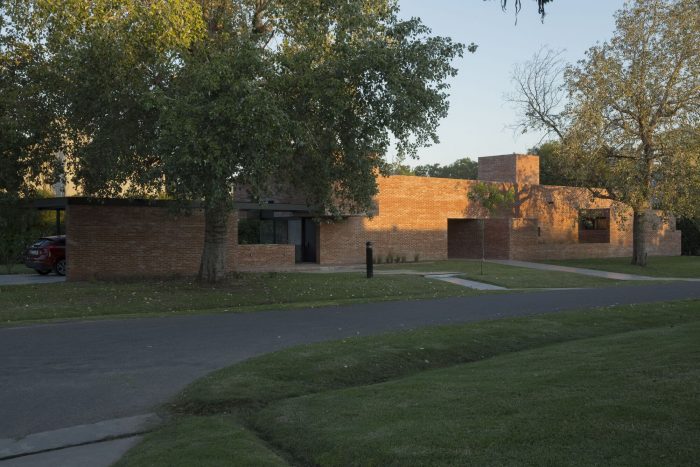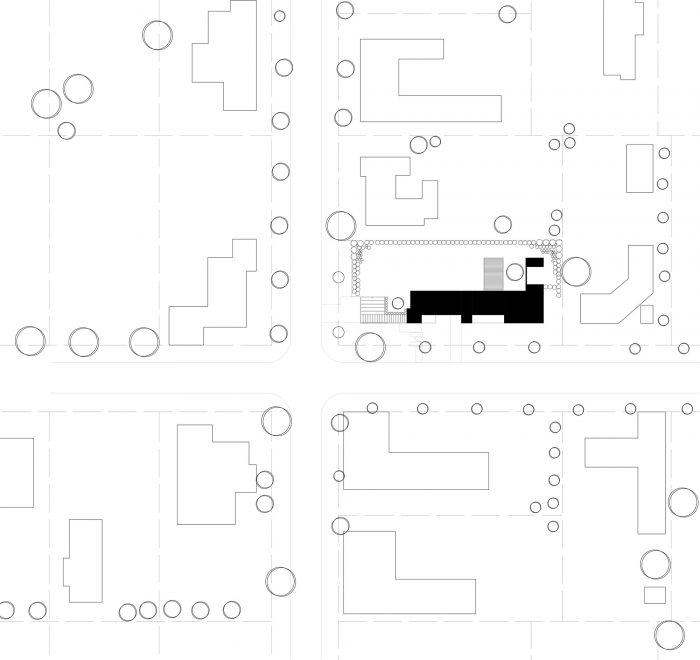Casa MJ156坐落在郊区私人庄园的一个角落里。这种给定的条件,一个典型的领土,在传统意义上的不同的城市性,总是一个挑战,一个通过具体项目进行反思的机会。
Casa MJ156 sits on a corner lot within a private suburban estate. This given condition, a typified territory, of a different urbanity in traditional terms, is always a challenge, an opportunity for reflection through a specific project.
由于该地区的监管退出,该地段在南北方向上有一个非常细长的比例。当从南端看向街道时,人们会被一种距离感所震撼,尽管建筑环境很遥远。这种远景是决定该项目基本决定的主要观察点:保持景观的这一维度。
Due to the regulatory withdrawals of the area, the lot has a very elongated proportion in a north-south direction. When looking from the south end towards the street, one is struck by a sensation of distance, of remoteness, despite the built environment. This long view is the primary observation that determines a fundamental decision regarding the project: to maintain that dimension of the landscape.
然后,建筑群在长边延伸,反过来形成了街道和天井之间的界限,控制了西边的方向。
The building mass stretches, then, on the long side, and in turn forms the limit between the street and the patio itself, controlling the west orientation.
房子的形式表达来自于一个削弱较大的想象体量和增加其他较小体量的过程,目的是为了平衡一个扩展的房子的形象。在所有的外表面(墙壁、地板、天花板)使用单一的材料,即砖,加强了这种几何穿孔的石头的想法。砖提供了统一性、颜色、质地、远距离的同质性,以及随着时间推移的良好老化。最终形象的稳固性支持了与西向的关系和对环境的隐私控制。同时与东面和北面的景观有更坦诚的关系,将每个室内外的过渡点作为一个主题来工作。
The formal expression of the house arises from a process of undermining a larger imaginary volume and the addition of other smaller volumes, with the intention of balancing the image of an extended house. The use of a single material on all exterior surfaces (walls, floors, ceilings), brick, reinforces this idea of geometrically perforated stone. The brick provides unity, color, texture, homogeneity from a distance, and good aging over time. The solidity of the final image supports the relationship with the west orientation and the control of privacy with respect to the environment. While having a more frank relationship with the landscape to the east and north, working with each interior-exterior transition point as a theme in itself.
在接近拐角处时,房子变得更轻,并且与建筑逻辑相反,变得非物质化。角落被定义为一个空洞,以最小的资源突出项目的这一时刻。
Approaching the corner, the house becomes lighter, and dematerializes, contrary to the construction logic. The corner is defined as a void that highlights this moment of the project, with minimal resources.
这是一个可以在行走中观察的房子。它伴随着从街道和地段内的行人路线。这块地没有失去最初的一米长度,没有失去看远的可能性,没有失去保持距离的可能性,没有失去控制与邻居的关系的可能性,没有失去尽可能地享受绿色的可能性,这是选择住在这个地方的主要原因。
This is a house to be observed while walking. It accompanies the pedestrian route both from the street and from within the lot. The lot has not lost a single meter of its initial length, of the possibility of seeing far, of keeping one’s distance, of controlling the relationship with the neighbors, of enjoying the green as much as possible, the main reason for choosing to live in this location.
有一种线性阅读是持续存在的,但是,一旦进入室内,在日常运动的发展中,一种斜视出现了,允许多达三种同时的视觉,三种景观尺度,三种方向和三种类型的光线。在每个室内线性路线的末端,都有一个绿色的视觉终点。在房子里也是在体验外面的空间,所需的绿色空间,由建筑控制,从延伸的凝视到细节的凝视,到特殊的情况,由每个设计决定划定:一个窗户,进入室内的砖头天花板,一个及时的规模变化。
There is a linear reading that persists, but, once inside, in the development of daily movements, an oblique gaze appears, allowing up to three simultaneous visuals, three landscape scales, three orientations, and three types of light. At the end of each interior linear route, there is a green visual finish. Being inside the house is also experiencing the outside space, the desired green space, controlled by the architecture, varying from the extended gaze to the gaze of detail, to the particular situation, delimited by each design decision: a window, a brick ceiling that enters the interior, a timely change of scale.
体积的表达与来自程序性的逻辑交替,但也来自象征性的逻辑,给这个环境带来了独立的建筑、强烈的个性和一些城市性。一个最小的城市性,也许是一个小镇的城市性。通过半公共庭院的主入口作为一个 “前花园”,服务入口被设计成一个 “门廊 “空间,以及庭院中一个具有大 “屋檐 “比例和处理方式的画廊,都说明了这种精神。在这条辨证的线路中,角落是空地,但就城市价值而言,是一个可用的空间。
The expression of volumes that alternate with a logic derived from the programmatic, but also from the symbolic, bring free-standing constructions, strong individualities, and some urbanity to this environment. A minimal urbanity, of a town perhaps. The main entrance through a semi-public courtyard as a “front garden”, the service entrance designed as a “porch” space, and a gallery in the courtyard with proportions and treatment of a large “eave”, speak of that spirit. Within this discursive line, the corner is the vacant lot, but in terms of urban value, an available space.
房子是简单的,友好的,在它的要求和尺寸上是有分寸的,就像它的主人住在里面的方式。这是一个最小的姿态,它在那里试图突出更大的东西:包含它的景观,以距离和无处不在的地平线为特征。
The house is simple, friendly, and measured in its requirements and dimensions, like the way its owners live in it. It is a minimal gesture, which is there to try to highlight something much larger: the landscape that contains it, characterized by distance and the omnipresent line of the horizon.
Architects: Navello Klotzman arquitectas
Area : 255 m²
Year : 2018
Photographs :Gustavo Frittegotto
Lead Architects : Sofía Navello, Ana Lina Klotzman
Collaborators : Agustina Coulleri, Hipólito Baccifava, Bruno Turri
Execution : Parmigiani-Valenti
Structural Calculation : Gonzalo Garibay + Asociados
Landscaping : Analía Capdevila
City : Funes
Country : Argentina












































